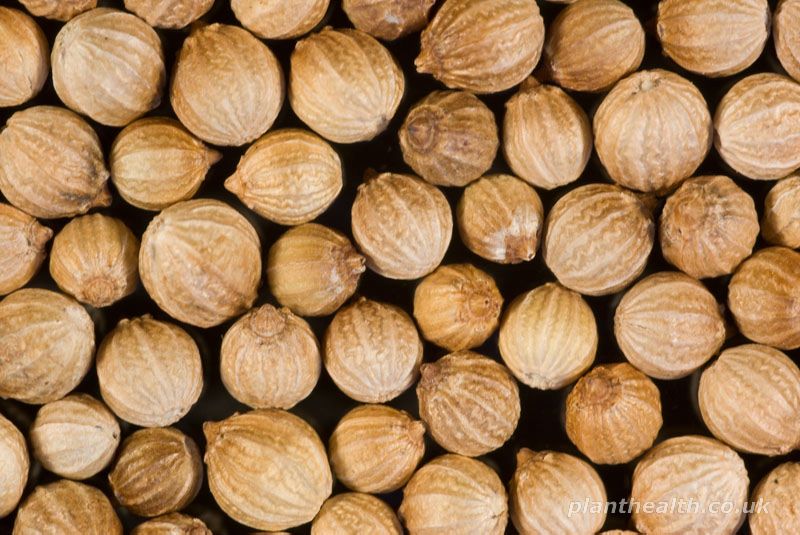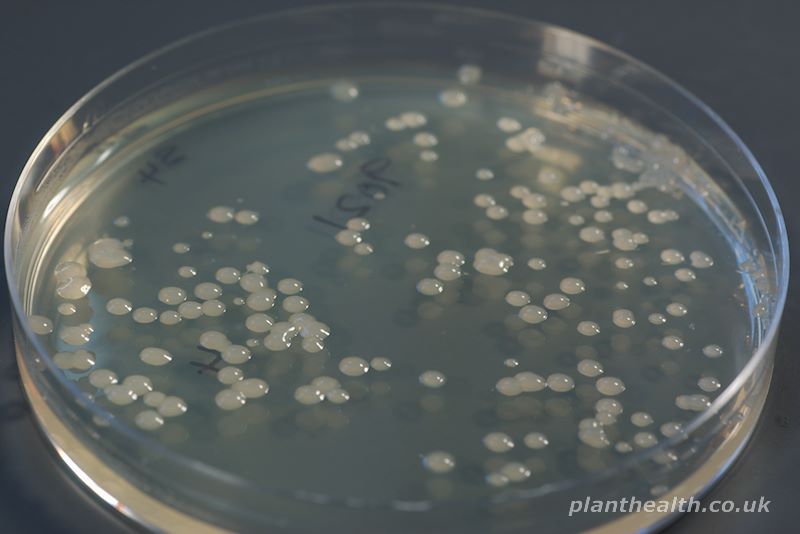How clean is your (coriander) seed?
By Steve Roberts, 26 Sep 2017
What's been happening?
We have heard that there have been a number of coriander crops affected by bacterial blight (Pseudomonas syringae pv. coriandricola) in the UK this year (2017). The disease is primarily seed borne, so if you start with clean seed there should be no disease.
What do we mean by clean seed?
To most people this means that the seed is completely free from the pathogen. BUT looks can be deceptive, the seed lot in the photo looks clean and healthy: in fact testing revealed it was heavily infested with with pv. coriandricola.
How clean is clean?
We can only ever test a sample of seed from a seed lot. This means we can never be 100% certain that the seed lot as a whole is clean. So don't believe anyone that tells you a seed lot is 100% completely disease-free, it means they don't know what they are talking about! The bigger the sample we test, the more confident we can be that a negative result means that risk of disease in the seed is relatively low.
How reliable is the test?
All test methods (however fancy) have an analytical limit below which they cannot reliably detect the pathogen, e.g. typcially it might be 10, 100, 1000 bacteria per seed or per-sub-sample. This depends partly on the details of method and also on the number of seeds that are tested in one batch. The bigger the batch, the less chance there is of detecting a single infected seed in that batch.
So what does all this mean in practice?
It means that to minmise the risk of disease in the crop, you need to test a certain minimum number of seeds, in batches of a certain maximum size, using a defined test method. To define the method and set these values requires an understanding of the test method itself, and knowledge of the rate of disease transmission from seed to seedling, and the rate of spread of disease in the crop. That's where Plant Health Solutions comes in.
A few years ago (2007-2010) we did some research to do just that. The work was funded by the growers through HDC (now AHDB-Horticulture). Based on this work and some fancy mathematical modelling and statistics, we came up with a recommended standard of 0.03% with an analytical sensitivity of 900 CFU (colony forming units). That means testing 9,000 seeds in total as three sub-samples of 3,000 seeds.
Then why have we had disease outbreaks?
If this standard was being applied throughout the industry, we would be very surprised to see any significant disease outbreaks. The fact that we have done means one or more of:
- Seed is not being tested.
- Seed is being tested but not to the right standard.
- Seed is being tested but not by the right method.
- The standard is not adequate.
We can't be sure, but our suspicion is that recent outbreaks are result of one of or combination of the first three. Possibly due to complacency, economics, or lack of knowledge/information. Its also easy to get complacent if we have a couple of dry years. Seed testing for bacterial pathogens is often seen as relatively expensive, and but this has to be weighed up against the cost of crop losses, especially when there are no disease control options in the field.
Seed treatments
Hot water treatment can be effective in reducing the bacterial load on coriander seeds to safe levels. But how effective it is is very much dependent on the particular seed lot, the starting level of inoculum and its location (surface and/or internal). Thus it is vital to do a post-treatment test to ensure that the treatment has been effective.
The way forward
From our perspective, that's easy - just send your coriander seed to Plant Health Solutions for bacterial blight testing. There are other companies that may be able to test coriander seed for bacterial blight, and they may be able to do a great job, but we don't know of anyone offering the test. What we can say is that we developed the test method that was used in the work to set the seed health standard, so we think we are best people to do the job.
Testing is not cheap, so is best done on a per-seedlot basis by the seed suppliers. That mean growers need to ask their suppliers for information on whether the seed has been tested and to what standard, at the very least how many seeds were tested and who did the testing.
References
- Green K; Roberts SJ (2010) Outdoor herbs: Integrated management of parsley septoria and coriander bacterial blight. Final Report 2007-10, FV 318. Stoneleigh, UK: HDC. (Report)

- Roberts SJ (2012) The potential of the coriander bacterial blight pathogen to infect parsley. HDC Project FV 403. Final Report. Stoneleigh, UK: HDC. (Report)

- Roberts SJ; Green, KR (2012) Coriander bacterial blight. HDC Factsheet 29/12. Stoneleigh, UK: HDC

- Roberts SJ (2010) Development of a seed health standard for coriander bacterial blight. 8th International Conference on Pseudomonas syringae and related pathogens, Oxford, 31 Aug to 03 Sept 2010. (Poster, abstract)

Tags: plants; diseases; bacteria; coriander; bacterial blight; Pseudomonas; seed testing


